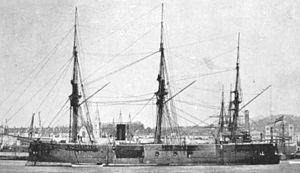Name HMS Pallas Laid down 19 October 1863 Fate Sold on 20 April 1886 Construction started 19 October 1863 Length 69 m | Completed 6 March 1866 Beam 50 ft (15 m) Launched 14 March 1865 Displacement 3.442 million kg | |
 | ||
HMS Pallas was a purpose-built wooden-hulled ironclad of the Royal Navy, designed as a private venture by Sir Edward Reed, and accepted by the Board of Admiralty because, as an economy measure, they wished to use up the stocks of seasoned timber held in the Woolwich Dockyard. The fact that Woolwich was not equipped to build iron ships was also relevant.
Contents
Background and design
She was built as a box-battery ship, with two of her big guns on either broadside and the others mounted in the extreme bow and stern as chase guns. It was possible to achieve axial fire from the battery guns by traversing them to fire fore or aft through recessed embrasures at the corners of the battery. As with similar arrangements in contemporary box-battery ironclads, moving the guns in anything other than calm water would have been extremely hazardous. The small number of guns, and the low weight of the broadside, was excused on the basis that the ship's primary weapon was the ram.
Pallas was the first warship in the Royal Navy to be fitted with compound expansion engines, and a high performance was expected from them; her specification claimed a speed under power of fourteen knots, which was necessary if she were to ram enemy ships who were themselves under way. On her trials, however, riding light, she achieved only 12.5 knots (23.2 km/h), while piling up an enormous bow wave. After her bow contour was hastily modified she was able to just reach 13 knots (24 km/h), which in the event of armed conflict would have been insufficient to allow her to fulfil her designed ramming function against any enemy ship with an operational power plant.
Service history
HMS Pallas was commissioned at Portsmouth, and served with the Channel Fleet until September 1870, when she was paid off for a long (and very early) refit. She served in the Mediterranean Fleet from 1872 to 1879, and was paid off. She was retained in fourth class reserve at Devonport until sold.
